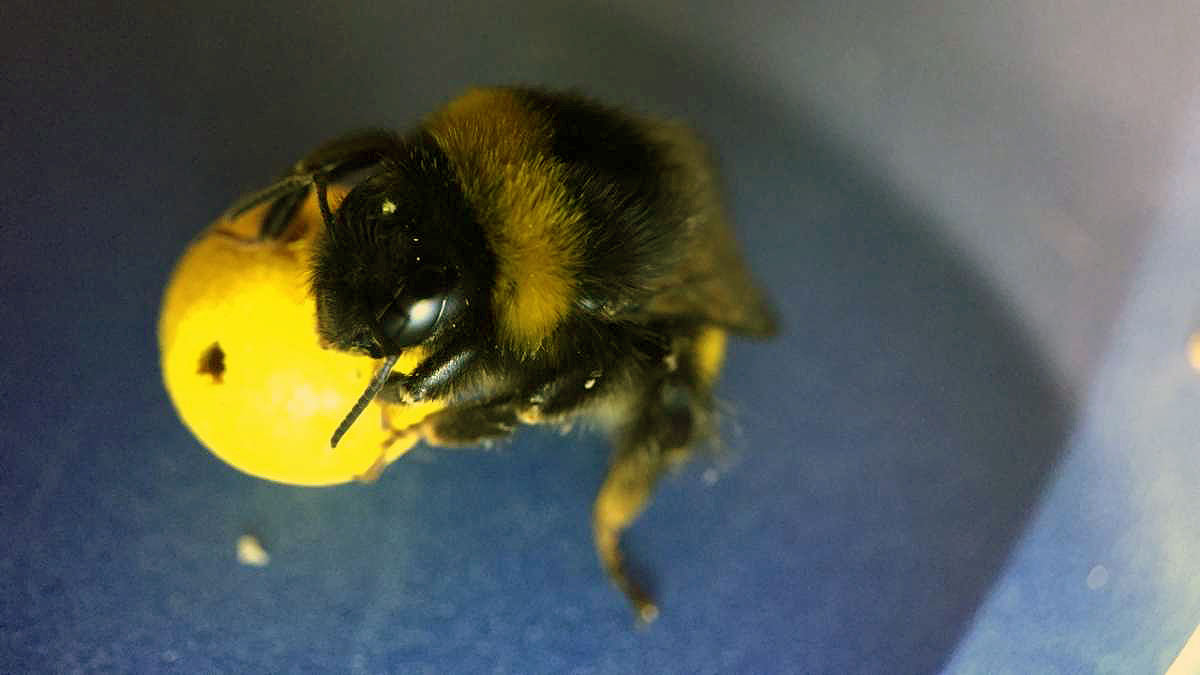The new premier league players
“The bees solved the task in a different way than what was demonstrated, suggesting that observer bees did not simply copy what they saw, but improved on it,”
Queen Mary, University of London’s School of Biological and Chemical Sciences (QMUL)
Back in February main stream media were amazed at a story that demonstrated the humble bumble bee could play football. Obviously, the bees had not acquired a new fondness of sport but what they had shown was cognitive flexibility under ecological pressure. Loukola et al.’s experiment with bumble bees shows tool use can now be extended to invertebrates, having previously only ascribed to humans, primates, marine animals and birds.
The team from Queen Mary, University of London’s School of Biological and Chemical Sciences (QMUL) published their findings in Science and are the first to show this ‘unprecedented behaviour’. The experiment did involve the bumble bees (Bombus spp.) utilising a bee sized yellow football to gain rewards, so the mainstream wasn’t wrong in suggesting the team had trained bees that could play football. The bees were trained to push a yellow ball towards a central platform to release a door that allowed access to a sucrose solution (sugar).
The Bees were trained using three methods; one group watched pretrained bees complete the task, another cohort watched a ‘ghost’ ball being moved using a magnet under the platform and a final ‘control’ group had no demonstration.
After pre-training all bees to find 30% sucrose solution in a hole under a half-ball in a square blue platform, bees were allocated to three demonstration groups for training (three trials). The social group received demonstrations by a live conspecific moving the furthest of three balls located at various distances from the center of a large blue platform, to the center to gain reward. The nonsocial group received a ghost demonstration via moving the furthest ball with a hidden magnet. The bees that did not receive demonstration (No) found one ball at the center of the platform already with reward. Research paper: Bumblebees show cognitive flexibility by improving on an observed complex behavior. Adapted from: https://www.researchgate.net/publication/313940786_Bumblebees_show_cognitive_flexibility_by_improving_on_an_observed_complex_behavior [accessed Apr 5, 2017].
The group that watched their peers did the best but what was startling was that they improved on their demonstrators. Instead of just copying the demonstrators the ‘bee trained’ group complete the task more efficiently. The demonstrators had been trained to move the furthest yellow ball towards the platform, the bees they trained quickly learnt to move the closest ball to the target to get the reward, regardless of the colour of the ball.
“The bees solved the task in a different way than what was demonstrated, suggesting that observer bees did not simply copy what they saw, but improved on it,” says joint lead author Dr Olli J. Loukola. “This shows an impressive amount of cognitive flexibility, especially for an insect.”
The findings would suggest that human prejudices of brain size to body mass ratios mean nothing when it comes to the ability of animals and insects to cognitively adapt to ecological pressures. This may mean that wild bees may still be able to reverse the changes to their population numbers which have been declining for decades.
“Our study puts the final nail in the coffin of the idea that small brains constrain insects to limited behavioural flexibility and only simple learning abilities,” says QMUL’s Professor Lars Chittka.
Slowing the decline
Whilst the study gives promising insights into the cognitive adaptability of the bees, it’s very debatable that the current ecological pressures being imposed on bees will be overcome through this adaptability. Bumble bee numbers in the wild had already declined in the in the 70s.
Pesticides, especially insecticides, are often blamed for bee and other pollinator losses. Particular concern has been raised about some neonicotinoid insecticides (especially clothianidin, imidacloprid and thiamethoxam). These systemic insecticides were used by farmers and gardeners to control a wide range of pests.
Attention has been focused on this group of insecticides because minute quantities of these systemic chemicals get into sap, nectar and pollen of treated plants. In addition, several bee poisoning incidents with these neonicotinoids have occurred abroad as a result of incorrect application by farmers and some research has shown harmful, often sub-lethal effects on the foraging ability of honeybees and the colony size of bumblebees. However, other research showed no clear evidence of harm being caused to bees when the chemicals are applied correctly.
Beyond pesticides habitat change, disease, competition between species and climate change may all be playing a part in the decline. It is plausible to think bees could adapt to one ecological pressure but multiple threats may require Herculean like adaptation.
The Royal Horticultural Society (RHS) has a good website describing the threats faced by our bees and what individuals can do to aid them in their struggle.
This study highlights we are only beginning to understand the complexity and ability of life on earth, we may be the supreme species but being ubiquitous does not mean we have unique abilities. Preservation of Bees is not only vital for furthering our scientific knowledge it is vital for our own survival, with pollinators like bees being an integral part of our ecosystem.
The Bees demonstrate an impressive amount of cognitive flexibility. © Copyright Olli Loukola/QMUL
Reference(s)
- OLLI J. LOUKOLA, CLINT J. PERRY, LOUIE COSCOS, LARS CHITTKA Bumblebees show cognitive flexibility by improving on an observed complex behavior. Science, 24 FEB 2017 : 833-836
- Paul H Williams The Distribution and Decline of British Bumble Bees (Bombus Latr.) Journal of Apicultural Research,21(4), 236–245. http://doi.org/10.1007/s40618-015-0336-1
7 Amazing Health Benefits Of Bee Pollen
[spacerpanel id=”2″]More in Science[/spacerpanel]
- This alloy is kinkyon April, 2024 at 4:07 pm
Researchers have uncovered a remarkable metal alloy that won t crack at extreme temperatures due to kinking, or bending, of crystals in the alloy at the atomic level. Unlike most materials, the new alloy keeps its shape and resists cracking at both high and low temperature extremes, making it […]
- Giant galactic explosion exposes galaxy pollution...on April, 2024 at 4:07 pm
Astronomers have produced the first high-resolution map of a massive explosion in a nearby galaxy, providing important clues on how the space between galaxies is polluted with chemical elements.
- AI and physics combine to reveal the 3D structure...on April, 2024 at 4:05 pm
Based on radio telescope data and models of black hole physics, a team has used neural networks to reconstruct a 3D image that shows how explosive flare-ups in the disk of gas around our supermassive black hole might look.
- Warming of Antarctic deep-sea waters contribute...on April, 2024 at 5:18 pm
Analysis of mooring observations and hydrographic data suggest the Atlantic Meridional Overturning Circulation deep water limb in the North Atlantic has weakened. Two decades of continual observations provide a greater understanding of the Earth's climate regulating system.
- Octopus inspires new suction mechanism for robotson April, 2024 at 8:52 pm
A new robotic suction cup which can grasp rough, curved and heavy stone, has been developed by scientists.
- One third of China's urban population at risk of...on April, 2024 at 8:51 pm
Land subsidence is overlooked as a hazard in cities, according to new research. Scientists used satellite data that accurately and consistently maps land movement across China.



